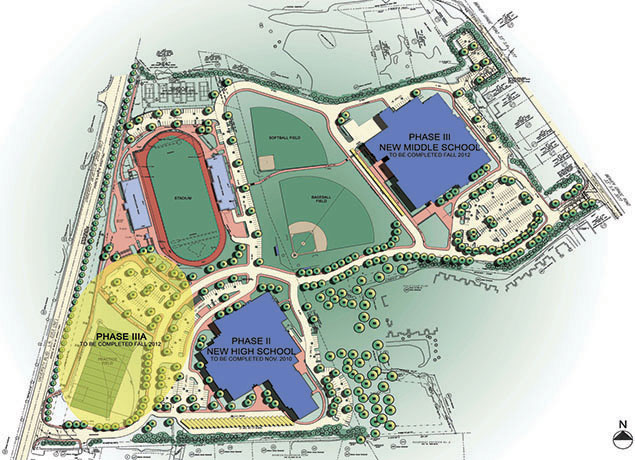
Engineering Systems
The New Moon Area High School and District Administration Offices are being delivered to the Moon Area School Districti using a traditional Deign-Bid-Build delivery method. The district awarded lump sum contracts totaling $62 million to 13 prime contractors in December 2008 and construction began in February 2009. The general contractor for the project is Nello Construction from Canonsburg, Pennsylvania. As part of their contract, Nello is the Lead Contractor for the project. This means Nello is responsible for coordination, overall project schedule and general site conditions for the duration of construction. For the completion of the project the school board also chose to acquire the services of a CM Agent. For this, N. John Cunzolo was chosen to oversee the day-to-day work and act as the owner’s representative. All insurance for contractors and registered subcontractors is provided by the owner through an OCIP. The Owner Controlled Insurance Program ensures that all parties have the appropriate insurance and may also help the owner save money.
The construction of the high school is second phase of a four phase project to remodel the entire Moon Area Campus. The project architect selected by the school board is Eckles Architecture & Engineering from New Castle, Pennsylvania. Eckles is responsible for the design of the high school and all of its systems along with the renovation of the old high school into a new middle during the next phase of the project. The image below depicts the final three phases of the campus overhaul.

Figure 1: Rendering of Final Site Conditions
The Moon Area School District’s power is supplied by Duquesne Light. The building will be provided with (2) 5,000A, 480Y/277V 3Φ, 4-wire service feeders. These feeders will enter the building from the southeast corner of the ground floor near Area G. Once the service enters the building the 480Y/277V is distributed through (2) main switchboards. The 208Y/120V power is provided by (6) step-down transformers located throughout the building. The high school is equipped with two back-up systems; a UPS and a diesel powered generator. The UPS is designed to provide 17 minutes of emergency power. The generator and fuel tank are sized to supply 250 kW of 480Y/277V for a period of up to 24 hours.
The overall lighting scheme throughout the high school will utilize 60+ fixture and lamp combinations. The design incorporates the use of LED, fluorescent tube and Metal Halide light sources. All fixtures are powered by 120/277V lighting circuits. The majority of the lighting in the classroom spaces is provided by suspended direct/indirect fluorescent tube fixtures. The fixtures have three bulbs and will be double ballasted to allow for optimum light control during school hours. The classrooms will also be equipped with motion sensors to ensure that lights do not remain on in unoccupied spaces.
The high school will feature an air-water heating and cooling system. The building’s main heating and cooling is supplied by (130) single zone heat pumps. The pumps are supplied with hot and cold water by (3) natural gas boilers and (2) fluid cooling units (cooling towers). Both the boilers and the sumps for the cooling towers are located in the boiler room on the ground floor in Area D. The heat pumps are used to supply heating and cooling to the classroom areas of the building. Fresh air for the classrooms is supplied by (11) rooftop 100% outside air units with heat recovery. All other heating and cooling needs are supplied by combination of RTU’s, AHU’s and cabinet heaters. The AHU’s service the district administration office, pool area and team locker rooms and are located in the mechanical and boiler rooms on the ground floor in Areas D and G. The (3) AHU’s that service these areas are a combination of variable and constant volume units. The (9) RTU’s within the system service most of the public spaces in the building including the gym, auditorium, cafeteria and library. Like the AHU’s, the roof-top-units are a combination of variable and constant volume.
The main substructure of the building will rest on drilled caissons ranging from 24”-54” in diameter, at depths of 13’-40’. The load will be transferred to the caissons by a series of pile caps and grade beams. The ground floor will be support by a combination of traditional 8” slab-on-grade construction and 21” structural ribbed slabs. The majority of the superstructure will be comprised of structural steel members. The beams and girders are made from varying W-shapes, and the columns are a combination of W-shapes and HSS tube steel. The gym, auditorium and pool roof support is provided by LH and DLH long-span steel trusses that bear on reinforced masonry walls. The structures lateral load will be supported by a combination of moment frames and reinforced masonry walls positioned throughout. Some of the structural masonry walls will utilize Ivany Blocks. The Ivany Block system is designed to ensure that the reinforcing within the structural masonry walls is properly placed. The blocks are formed to align the placement of both the vertical and lateral steel bars. Finally, each above ground floor will feature a 6½” composite slab (3½” 4,000 psi lightweight concrete on 3”, 18 gauge, galvanized decking).
The fire suppression system will use both wet and pre-action systems designed in compliance with NFPA 13 and local authorities for a type 1B Educational facility. The gymnasium will be the only area of the building to utilize the pre-action system. This is often the case in school design because sprinkler heads in a gymnasium can easily be struck by flying objects. Using a pre-action system ensures that there is no accidental discharge in the event a head in broken. The overall sprinkler system is designed with each floor divided into (3) zones, each with its own control valve. The fire pump with be connected to the emergency generator to ensure the sprinklers are operable at all times.
The building will only require the services of one 2,500lbs hydraulic elevator. The elevator will be centrally located within the building, providing service to the high school and the district administration offices. The elevator will be equipped with a battery back-up system to ensure that it is safely returned to the ground floor in the event of a power outage.
The New Moon Area High School and District Administration Offices will feature a complicated mixture of telecommunication systems. As is the case in most schools, the building will use a telephone and intercom system to allow easy communication between rooms and allow for building-wide announcements to be made. Along with the typical voice and data outlets, each classroom will contain an Extron multimedia system. The system allows for easy control of all inputs to the ceiling mounted projector, this will include DVD/VCR units, computers, and wireless microphones. The Extron controls will also allow students and teachers to connect laptops to the projector for presentations. The entire building will have a wireless internet system for use will laptop stations purchased by the school district.
Along with the technology in each classroom, there will be many other room specific multimedia systems throughout the building. The gymnasium, cafeteria, natatorium and board room will all feature custom audio/video systems for use during school hours and extracurricular activities. The high school’s auditorium will contain adequate audio and visual equipment for activities ranging from movie playback and music recording to choral concerts and Broadway musicals. The high school will have its own TV station to be broadcast daily through the projectors in each classroom.
The high school will utilize a combination of video surveillance and entrance controls. All of the buildings entrances will remain locked during hours of operation. All admittance will be handled by administrators in the high school and district administration offices. Those wishing to enter the building after the day has started must state their purpose through a video intercom system at each main entrance. Once the guest is identified, the office administrators can remotely unlock the door allowing access to the building. Teachers and other faculty members will have access through secondary doors by means of card readers design to detect there ID badges. Daily activities within the public spaces of the high school will be monitored and recorded by a (112) camera, Closed Circuit Television (CCTV) system.
SENIOR CAPSTONE PROJECT:
The Capstone Project Electronic Portfolio (CPEP) is a web-based project and information center. It contains material produced from a year-long Senior Thesis class. Its purpose, in addition to providing central storage of individual assignments, is to foster communication and collaboration between student, faculty consultant, course instructors, and industry consultants. This website is dedicated to the resarch and analysis conducted via guidelines proveded by the Department of Architectural Engineering. For an explanation of this capstone design course and its requirements click here.
| AE Senior Thesis | The Pennsylvania State University | Architectural Engineering | Contact Kris |
